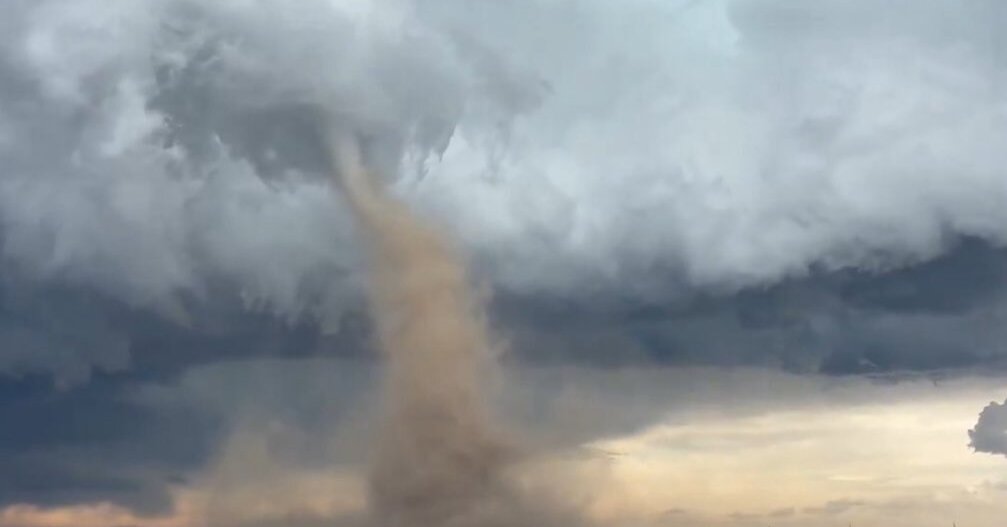Tornadoes tore through parts of the Great Plains on Sunday, downing power lines and trees and damaging buildings across several towns, cities and counties. They were part of a severe storm system that was expected to bring strong winds and hail the size of golf balls to parts of the Midwest through Monday.
More than 20 tornadoes were reported across Colorado, Kansas, Texas, Oklahoma and Nebraska on Sunday, according to the National Weather Service. The tornado warnings expired early Monday.
A tornado ripped through Grinnell, Kan., on Sunday night, tearing the roof off a church and destroying several other structures, according to photos shared by NWKS Radio. The city, which has a population of less than 300 people, is about 125 miles north of Dodge City.
A portion of Interstate 70 nearby was shut because of downed power lines, according to Lisa Mussman of the Kansas Department of Transportation. The storm has also downed power lines and trees in Kiowa County, Kan., the sheriff’s office said.
In Colorado on Sunday, there were multiple reported tornadoes in communities outside of Denver. A tornado touched down at least three times near Bennett, a town of about 2,800 people east of Denver, damaging 17 buildings, including six homes, the Arapahoe County Sheriff’s Office said.
Tornadoes in Elbert County, southeast of Denver, caused varying levels of damage to 19 homes, said Kara Gerczynski, the public information officer for Elizabeth Fire Rescue. Videos posted on social media showed funnel clouds tearing through neighborhoods in Colorado, some of which leveled homes and left behind scattered debris.
A tornado also hit Gordon, Tex., causing major infrastructure damage and some injuries, with four people taken to hospitals, the authorities in Palo Pinto County said. “The damage is pretty widespread across the community, with trees and power lines down everywhere,” the county’s emergency services said on social media, adding power was out in the community and that schools would be closed on Monday.
In the village of Stratton, Neb., a tornado took down power lines, the Hitchcock County Sheriff’s Office said.
The severe weather is expected to last into Monday night, according to the National Weather Service’s Storm Prediction Center. Forecasters warned of potential for “all severe hazards,” including hail larger than golf balls, strong winds and tornadoes.
The risk is spread across a broad slice of the middle of the country, but is focused on the central and southern Plains.
The outbreak of severe weather comes as the Midwest and the Northeast recover from a spate of deadly storms that generated several strong tornadoes on Friday. In Missouri and Kentucky alone, tornadoes killed at least 25 people, officials said. A rare dust storm swept across central Illinois and into Chicago.
The severe weather is hitting at a time when the Weather Service is facing staffing shortages after the Trump administration ordered cuts. Nearly 600 people have departed through layoffs and retirements.
A forecasting office in Jackson, Ky., which was directly in the line of Friday night’s tornadoes, is one of four no longer with enough staff to operate at all times.
It would have been without an overnight forecaster, said Tom Fahy, the legislative director for the union that represents Weather Service employees. But after an “all hands on deck” scramble, he said, the office stayed open and was fully staffed, issuing 11 tornado warnings.
The three other forecasting offices are in Sacramento; Hanford, Calif.; and Goodland, Kan. Four more, Mr. Fahy said, are days away from losing their overnight staffing: in Cheyenne, Wyo.; Marquette, Mich.; Pendleton, Ore.; and Fairbanks, Alaska.
The risk of tornadoes in the region will remain in place on Monday. There is expected to be some rain in the mix, too, with showers and thunderstorms likely to be more focused over the central Plains into Missouri and Arkansas.
By Tuesday, the storm system will shift eastward, bringing the threat of severe weather to the Midwest, Tennessee Valley and Ohio Valley.
“The biggest threat is going to be the wind and hail again, but the flash flood threat will also be there,” Mr. Hurley said. “It definitely is a May springtime pattern in the United States.”
Judson Jones, Yan Zhuang and Nazaneen Ghaffar contributed reporting.
Amy Graff is a Times reporter covering weather, wildfires and earthquakes.
Sara Ruberg covers breaking news and is a member of the 2024-25 class of Times Fellows, a program for journalists early in their careers.
The post Tornadoes Bring Destruction to Great Plains as Severe Weather Threat Persists appeared first on New York Times.




